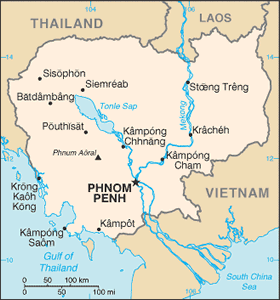The Geography of Cambodia
The Geography of Cambodia
Cambodian Geography
Location: Southeastern Asia, bordering the Gulf of Thailand, between Thailand, Vietnam, and Laos
Geographic coordinates: 13 00 N, 105 00 E
Map references: Southeast Asia
Area: total: 181,040 sq km land: 176,520 sq km water: 4,520 sq km
Area - comparative: slightly smaller than Oklahoma
Land boundaries: total: 2,572 km border countries: Laos 541 km, Thailand 803 km, Vietnam 1,228 km
Coastline: 443 km
Maritime claims: territorial sea: 12 nm contiguous zone: 24 nm exclusive economic zone: 200 nm continental shelf: 200 nm
Climate: tropical; rainy, monsoon season (May to November); dry season (December to April); little seasonal temperature variation
Terrain: mostly low, flat plains; mountains in southwest and north
Elevation extremes: lowest point: Gulf of Thailand 0 m highest point: Phnum Aoral 1,810 m
Natural resources: oil and gas, timber, gemstones, iron ore, manganese, phosphates, hydropower potential
Land use: arable land: 20.44% permanent crops: 0.59% other: 78.97% (2005)
Irrigated land: 2,700 sq km (2003)
Natural hazards: monsoonal rains (June to November); flooding; occasional droughts
Environment - current issues: illegal logging activities throughout the country and strip mining for gems in the western region along the border with Thailand have resulted in habitat loss and declining biodiversity (in particular, destruction of mangrove swamps threatens natural fisheries); soil erosion; in rural areas, most of the population does not have access to potable water; declining fish stocks because of illegal fishing and overfishing
Environment - international agreements: party to: Biodiversity, Climate Change, Climate Change-Kyoto Protocol, Desertification, Endangered Species, Hazardous Wastes, Marine Life Conservation, Ozone Layer Protection, Ship Pollution, Tropical Timber 94, Wetlands, Whaling signed, but not ratified: Law of the Sea
Geography - note: a land of paddies and forests dominated by the Mekong River and Tonle Sap


